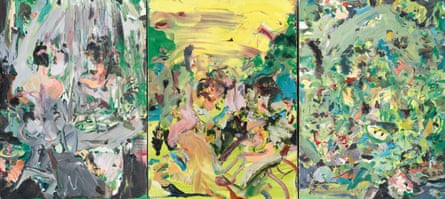“It’s like 1967,” said a visitor to the Metropolitan Museum of Art, as artists, writers, friends and art patrons assembled to celebrate British painter Cecily Brown, who came to Manhattan in the early 1990s and was this month gifted a “career survey” at the civilisation-spanning institution. The last time this accolade was offered to a living British artist was Lucian Freud in the mid-90s.
The reception that followed the Brown opening was described by one New York critic as an “oestrogen-fuelled, generational-shifting thrill, artistically and socially”. An early review noted that Brown “makes everything old new again”.
Her figurative abstractions tell stories, often many at a time, in ways that activate every inch of canvas; the work on show in Death and the Maid, which runs until 3 December, was energised by the attention, and returns the favour. “It’s beyond a dream,” Brown told the Observer after the opening last week. “It feels like boasting to even talk about it.”
If painters are storytellers, then Brown has stories to tell, and they can be barbaric, shredded and fragmentary. No better place to show, then, than in the Met, with its invitation to foragers of art and artefacts.
Brown left London after graduating from Slade School of Fine Art at a time when painting was out of fashion. In the era of the Young British Artists, many who would become successful looked beyond brush and paint.
Early in her career, she was celebrated for her embrace of sexuality, often depicted by frolicking bunnies and later with orgiastic human figures. Now she is 53, and the Met exhibition – 50 paintings, drawings and sketches grouped around a title derived from a Schubert string quartet, Death and the Maiden – is an opportunity to move the story along. Many works revolve around the themes of European painting: memento mori, the vanitas (still life paintings that symbolise mortality) and, as the Wall Street Journal noted last week, “the spectre of beautiful women flirting with death”.
The span includes Fair of Face, Full of Woe (2008), an abstracted spin on the Gibson Girl, the personification of female beauty in the 1890s by artist Charles Dana Gibson, now complemented with a skull; A Year on Earth, depicting a pair of entangled bodies in a cluttered room, painted during pandemic claustrophobia; Lobsters, Oysters, Cherries and Pearls, a tableau of luxuries celebrated in 17th-century Dutch still lifes; a watercolour from 1997 of three women inspired by the sadomasochistic compendium Jeux de Dames Cruelles (Games of cruel women); and another after Pieter Bruegel’s The Fight Between Carnival and Lent; and other distracted, syntheses of imagery that arrive at figurative abstraction.

“Like a magpie at work, there’s no hierarchy of sources,” Brown said. “It’s just the feeling of someone who looks at everything, takes what they will when it’s needed, churning it around, and spewing it back out as something else.”
The painter has pushed back against readings of her work that focused on sexualised imagery. “I could do a slash of pink and someone would assume it was something sexual even when it wasn’t,” she said. “There’s an advance reading where people expecting to see something end up seeing it.” In fact, she said, there’s not much erotica in her work: “It’s just been talked about so much” to the point it got in the way of the painting.
Instead, the show highlights subsumed strains of erotica and voyeurism. In No You for Me, from 2013, Brown turns the table – the viewer is really looking in the mirror at a nude, a reversal of the tradition of the post-coital woman depicted by painters from Boucher to Bonnard and Sickert.
“It’s complex as a woman to always be looked at in reality and in art,” she said. “In that painting, the viewer becomes the subject. It’s a feeling I think women will recognise.”
after newsletter promotion
Brown would sooner avoid discussing the great demand for her work, and more so in a setting of scholarship. “It’s nice to be wanted,” is all she allows. Still, her Free Games for May, a painting owned by the late Warner-Reprise record legend Mo Ostin, will go to auction at Sotheby’s New York next month with an estimate of $3-5m.
The Met survey presents an opportunity for reflection. When she moved to New York, Brown worked at a farmers’ market, as a waitress, an animator and, for a time, almost talked herself out of painting. “It’s hard to imagine now, but people really were anti-painting, and sometimes quite rightly, I think,” Brown said. “I resented the fact that I was a painter. Nearly everything I was seeing that I liked was other kinds of art, and I wished I could make cool Cibachromes [photographic prints] or sculptures, or think like a conceptual artist.”
As it has for many artists, the city became an inspiration in its own right: “I loved the light and physicality, looking up an avenue and seeing all the way up, or looking across when you’re in midtown. People don’t often mention how beautiful New York is. A lot was the feeling of freedom.”

Her father, the arts writer and critic David Sylvester, thought coming to Manhattan was a horrible idea. “He was convinced I’d be mugged,” she said. “All his warnings gave me a great adrenaline rush. I’d walk around the city by myself until I realised I really wasn’t [going to be mugged].”
Abstract art came about as a form of rebellion. “There’s a now-you-see-it, now-you-don’t aspect that’s true to the way I work,” Brown said of the exhibition. “Hopefully, it gives a sense of someone who has a range and is investigating things, coming back to things over and over, worrying a subject like a jack russell with a rat.”





More Stories
An unusual Salvador Dalí painting at the Art Institute of Chicago prompts a startling revelation
Wolfgang and Helene Beltracchi fooled the art market — and made millions
Commuters Go Wild in Matthew Grabelsky’s Uncanny Subway Paintings — Colossal